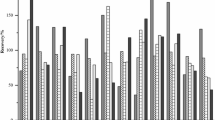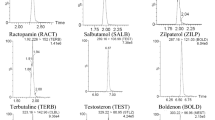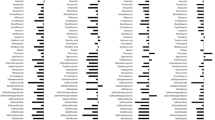Abstract
A novel UHPLC–MS/MS approach, using multi-period multiple-reaction monitoring (mpMRM), was developed for the detection of 46 veterinary drugs including representative beta-agonists, quinolones, sulfonamides, tetracyclines in food of animal origin samples. A simple procedure based on protein precipitation associated with ultrafiltration was employed to realize a generic sample preparation for food of animal origin. In particular, multi-period multiple-reaction monitoring (mpMRM) was developed as a MS scan mode for veterinary drugs to meet the requirements of qualitative and quantitative detection of multiple veterinary drug residues and improve sensitivity and reliability in this method. Furthermore, the method was fully validated for all 46 drugs, and the specificity, linearity, limit of detection, limit of quantification, accuracy and precision results are good. Using the developed method, 30 pork samples and 20 beef samples were analysed, and the result is consistent with that using GB methods (National standard method of the People’s Republic of China) but using less time, which demonstrates that our developed method is not only accurate and reliable, but also greatly improves the cost-effectiveness of the analytical procedures. This approach not only is much more effective than the traditional sample preparation method, but also provides data on four classes of veterinary drugs in one analytical run, which enabled high-throughput and efficiency. The obtained results proved the usefulness of the method as applied in the field of residue analysis.





Similar content being viewed by others
References
Bogialli S, Di Corcia A (2009) Anal Bioanal Chem 395:947–966
Wegener H, Aarestrup F, Gerner-Smidt P, Bager F (1999) Acta Vet Scand Suppl 92:51–56
Gentili A, Perret D, Marchese S (2005) TrAC Trends Anal Chem 24:704–733
Stolker A, Brinkman U (1067) J Chromatogr A 2005:15–33
Hernández-Arteseros JA, Boronat I, Compañó R, Prat MD (2000) Chromatographia 52:295–300
Sherri B, Susan B, Joseph M, Justin R (2012) J Agric Food Chem 60:4430–4439
Garcia MA, Solans C, Hernandez E, Puig M, Bregante MA (2001) Chromatographia 54:191–194
Stolker A, Zuidema T, Nielen M, Nielen M (2007) TrAC Trends Anal Chem 26:967–979
Shao B, Jia X, Wu Y, Hu J, Tu X, Zhang J (2007) Rapid Commun Mass Spectrom 21:3487–3496
Huang JF, Lin B, Yu QW, Feng YQ (2006) Anal Bioanal Chem 384:1228–1235
Tian Y, He J, Zhang R, Lv H, Ma S, Chen Y, Yu S, Chen X, Wu Y, He W, Abliz Z (2012) Anal Chim Acta 731:60–67
Huang JF, Zhang HJ, Lin B, Yu QW, Feng YQ (2007) Rapid Commun Mass Spectrom 21:2895–2914
Hermo M, Barrón D, Barbosa J (2008) J Chromatogr A 1201:1–14
Shao B, Dong D, Wu Y, Hu J, Meng J, Tu X, Xu S (2005) Anal Chim Acta 546:174–181
Sergi M, Gentili A, Perret D, Marchese S, Materazzi S, Curini R (2007) Chromatographia 65:757–761
Bruno F, Curini R, Corcia AD, Nazzari M, Pallagrosi M (2002) Rapid Commun Mass Spectrom 16:1365–1376
Huck C, Bonn G (2000) J Chromatogr A 885:51–72
Heitzman R (1992) Veterinary drug residues. Residues in food-producing animals and their products: reference materials and methods; Office for Official Publications of the European Communities
GB/T 21317-2007 (2007) Determination of tetracyclines residues in food of animal origin LC-MS/MS method and HPLC method
GB/T 20759-2006 (2006) Method for the determination of 16 sulfonamide residues in livestock and poultry muscles- LC-MS/MS method
Bulletin 1025-18-2008 (2008) Determination of beta-agonists residues in animal derived food by liquid chromatography-tandem mass spectrometry. Ministry of Agriculture, People’s Republic of China
Bulletin 1025-14-2008 (2008) Determination of fluoroquinolones residues in animal derived food by high performance liquid chromatography. Ministry of Agriculture, People’s Republic of China
Author information
Authors and Affiliations
Corresponding authors
Ethics declarations
Funding sources
This study was supported by the Agriculture Department of China for the risk assessment project of animal product (Project No. GJFP2015008).
Conflict of interest
The authors declare no competing financial interest.
Rights and permissions
About this article
Cite this article
Tian, Y., Jia, J., He, J. et al. Simultaneous Detection of 46 Veterinary Drug Residues in Animal Meat by UHPLC. Chromatographia 79, 457–471 (2016). https://doi.org/10.1007/s10337-016-3041-0
Received:
Revised:
Accepted:
Published:
Issue Date:
DOI: https://doi.org/10.1007/s10337-016-3041-0




